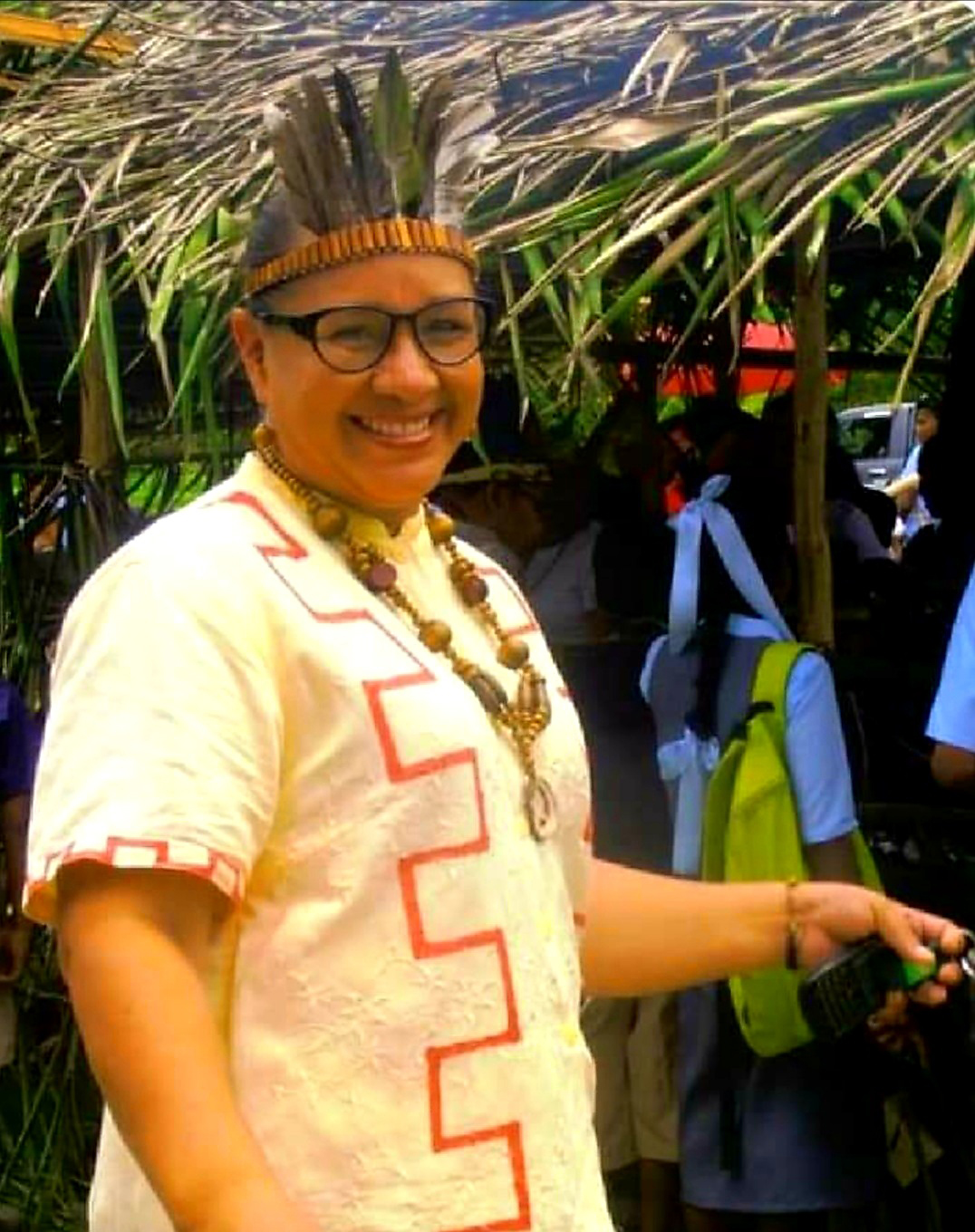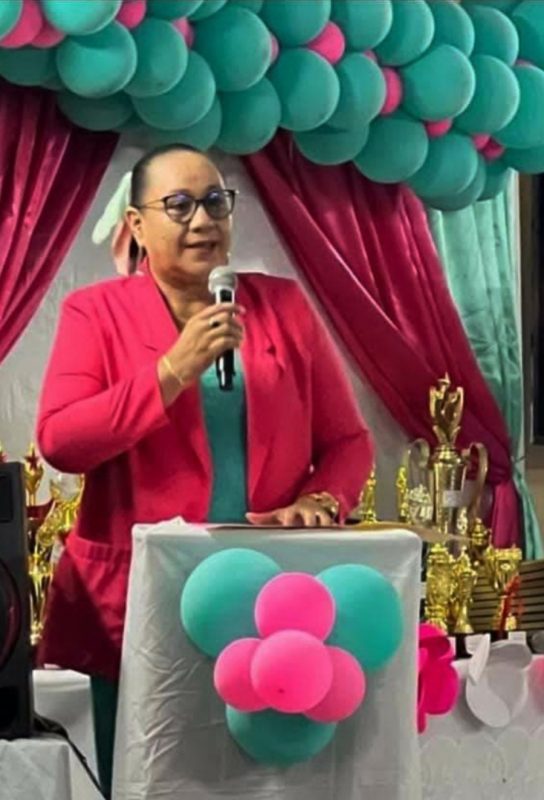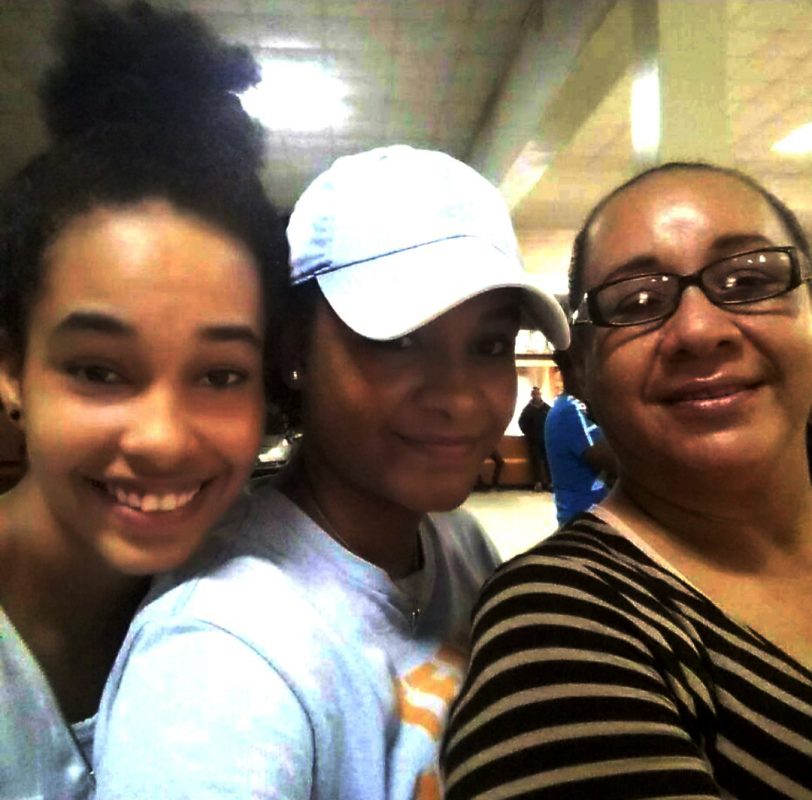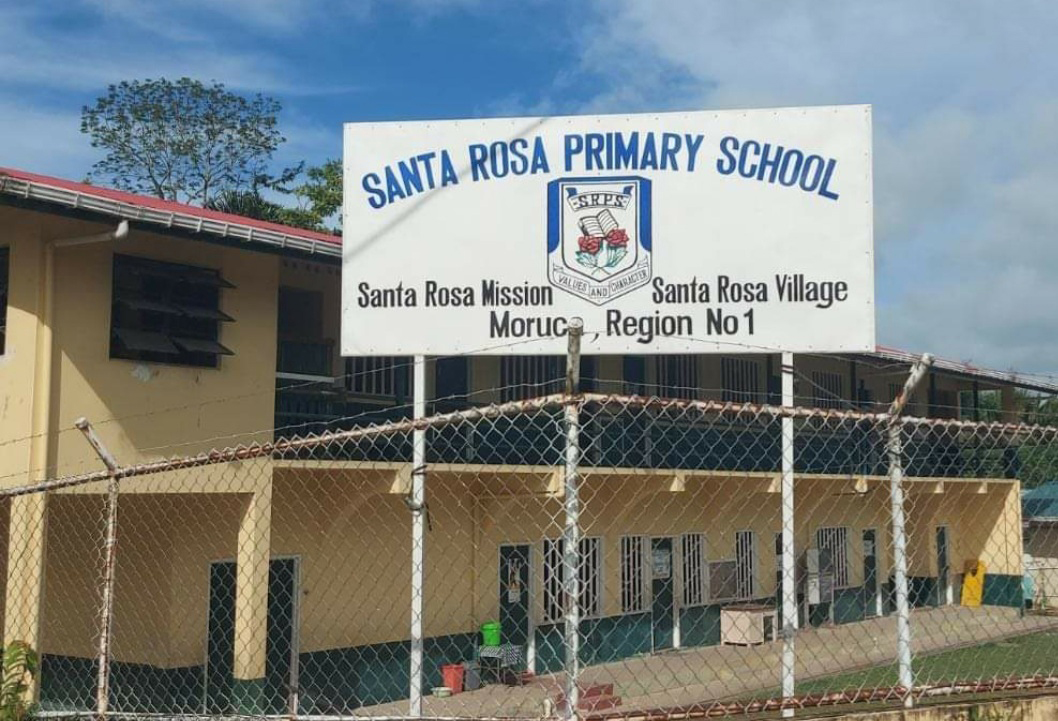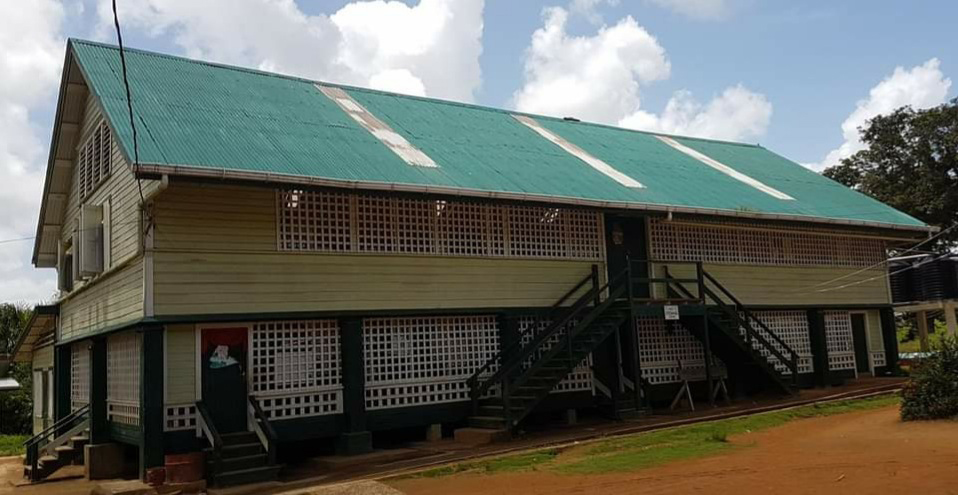Educator Hermina Rebeiro-Richards attended, taught and administered an overcrowded Santa Rosa Primary School (SRPS) in Santa Rosa, Moruca, Region One (Barima/Waini) but by the time she retires next April after more than 30 years in the teaching profession, she hopes that the decades-old issue of overcrowding would be a thing of the past.
“The Region One administration has constructed a new building with four classrooms, which is yet to be handed over. At a recent headteachers’ meeting, the administration promised that furniture will be coming very soon from Mabaruma. We are very short of furniture so we cannot move into the new building… That building will solve the problem of overcrowding for now,” she told Stabroek Weekend.
The 54-year-old Rebeiro-Richards is the longest serving substantive headteacher of the school. At present, she has been there 14 years.
She said the historic main building, which was built to accommodate 200 children, is now accommodating 320 and “ram jam”. The main building and two annexes built in later years accommodate over 600 pupils and teachers. There were 618 pupils on roll at the end of the last school year. Of that number, 90 from Grade Six have gone on to secondary schools. However 100 pupils have enrolled for Grade One with more expected.
The two-storey main wooden building, an open plan, is a historical landmark the community is proud and protective of. It was condemned last year by the region’s engineers.
“At one time, two benches backing each other separated classes. Downstairs was the primaries and upstairs the forms. My common entrance classroom was a separate building where the nursery school is now,” Rebeiro-Richards stated.
“Last year, we fought for the building to be repaired because it is a historical landmark and the repairs were completed. When one end of the building was shaking, the then Chief Education Officer (CEO) advised us, after a visit, to close that section and operate the school on a shift system. A number of retired teachers were instigated to protest the closure and the shift system claiming the building was strong. Up till now, I get emotional when I think about that protest. Parents and some teachers went on a counter protest. I didn’t go. The protests caused the CEO to come to Moruca to see the state of the school building,” she recalled.
Makeshift classrooms using tents were erected but they weren’t conducive to learning.
That period, Rebeiro-Richards said, was her most challenging as headmistress. Her representation was ignored by the regional administrators until she bypassed them and approached the Ministry of Education for help. When the regional administration finally made an appearance she explained in detail the efforts she made to resolve the issue within that structure.
“When the regional chairman finally heard my side of the story and realised the problem was the region’s, he in turn lambasted his officers in front of us. When they bowed their heads and I started to clap like a mad woman, the teachers and parents all joined in,” she recalled.
“On January 3rd 2006, the students from forms one to four were transferred to Santa Rosa Secondary School (SRSS) but that did not ease the overcrowding.”
She will retire next April knowing the children and staff will be more comfortably accommodated for teaching and learning to take place. She applauded the school’s parent teachers’ association chairman Donna Henry, who also pushed the issue and never backed down.
Since the 1960s, overcrowding has been an issue. A troolie hut was built between the church and the main school building to accommodate children preparing for the common entrance examinations. Not certain when the landmark structure was built, Rebeiro-Richards noted that from the school’s records, formal teaching began at Santa Rosa in 1817. Formerly a Roman Catholic school it was taken over by the government in 1976.
In spite of overcrowding, SRPS, which historically has produced a number of outstanding Guyanese, continues to see performances among the top ten students in Region One at the National Grade Six Assessment. “Twice during my tenure, we had six out of ten. This year we had one national scholarship and five regional. We got those in spite of all the hiccups we were facing, including the shift system, but our staff is hardworking and committed,” she noted. One of her achievements was computerising all the school records. “I learned to use the computer by trial and error. I learned to type on a typewriter. I used up about three or four of my own laptops doing the school’s work. The staff raised funds to buy two or three printers on separate occasions. I started printing test papers for all the children at every end of term,” she said.
Apart from this month being dedicated Education Month, it is also being observed as Amerindian Heritage Month and the teachers at SRPS have begun preparations to mark both occasions.
“Our observances are mandatory. Our heritage day activities will be observed on September 8 this year. This year we plan to reintroduce a heritage pageant. We plan our activities on a house basis. We have five houses, the last, Pink, was introduced by SRSS in honour of the late Chief Medex Lolita Rebeiro, my sister, a former pupil of SRPS and SRSS,” she said.
All-round educator
Rebeiro-Richards has on several occasions acted as a district education officer when the substantive hire took annual leave. Because of this, headteachers share their views with her and the newly-appointed ones seek her help.
She has also been conducting the education management certificate course for senior teachers in the Moruca sub-region since 2012 in collaboration with the National Centre for Educational Resource Development.
Once she conducted the programme for Region One because Mabaruma and Port Kaituma had no master trainer. “Every two years we have senior teachers doing that course. I recently finished a course and started with another batch in February this year,” she added.
Along with two other teachers, who are no longer in the system, she took part in a Basic Education Access and Management Support programme on methodology. “Based on that programme we introduced the national ‘Literacy Hour’ in schools in the sub-region which is still ongoing,” she said.
Early childhood
The third of 13 siblings, Rebeiro-Richards said her family was poor even though her mother was a teacher and her father, a farmer, worked out of Moruca for long periods of time.
“It was tough. I attended school sometimes barefoot but then it was fun. The majority of schoolchildren went to school barefoot. Sometimes some of us wore slippers or sneakers but then sometimes we lost them. That was not a setback. To help my mom, I sold to my classmates some fudge and sugar cake she made,” she recalled.
“Sometimes, after school, instead of crossing the river [Moruca] with the boat, I’d leave my books under my desk at school and go swimming with other children especially during the dry weather. The boys swam with their books or clothes in their hands above the water.”
After writing the common entrance examination in 1982, she attended St Joseph High School in Georgetown on a hinterland scholarship.
It was her first time in the city, and Rebeiro-Richards recalled her first day walking to school from Duke Street, Kingston into Cowan Street, then into Woolford Avenue and telling everyone she met “Good morning” as she was used to at home. When no one replied to her greetings, she realised she was in a different cultural setting.
Rebeiro-Richards, then 12 years old, and two other girls who were also hinterland scholarship awardees were placed with a guardian of East Indian origin in Kingston. The guardian had a 14-year-old daughter.
Rebeiro-Richards and another girl were Amerindians and the third was of East Indian origin from the hinterland.
“They treated the East Indian girl favourably and they treated me and the other girl like outcasts,” she recalled.
One Saturday morning at the end of the school term, the guardians took the East Indian girl to the market and left Rebeiro-Richards and the other girl to mop the house. “It was a three-storey house and we had to mop out the entire house,” she related. “Their daughter who didn’t go with them, was foot-and-foot behind us while we were mopping. At one stage she asked me, ‘How you mopping like a buck?’ I said, ‘What?’ I felt insulted and angry. I took the mop stick in my hand and beat her with it. The other girl pushed me away from her but her skin was already black and blue. Her parents used to refer to us as ‘bucks’ and they used the word often in the house. I never said anything but I cried a lot.”
Because of that incident Rebeiro-Richards and the other students were placed with separate guardians. Rebeiro-Richards was placed in Albert Street, Queenstown with the late Eloise Ross aka Sister Lou.
“Sister Lou was such a nice person. However, in my fifth and final year at high school, a student got away one night when a welfare officer visited. We never told Sister Lou that this girl got away regularly and we were scolded. A bike used to pick her up at the corner of Church and Albert streets. I was okay at Sister Lou but because of what had happened, Sister Lou decided she wasn’t keeping girls anymore. Because of that we all had to move,” she reminisced.
After she finished high school in 1987, she continued on a hinterland scholarship at the Government Technical Institute where she spent one term on the secretarial science programme. During the Christmas holiday, the then headmistress Bridget Daniels, unaware that she was at GTI, offered her a teaching post at SRPS and she accepted.
“It was hard on my parents and I decided to teach to earn some money and help them. I started teaching on January 6, 1988,” she said.
She taught for a year and six months. In 1989, the then deputy regional executive officer offered her a job as an accounts clerk at his office. She submitted her resignation to the school on a Friday and started at her new job the following Monday. She held the post for three years but realised there was not much scope for upward mobility in that position. She wanted to return teaching but not as an untrained teacher.
“Subconsciously, I followed up on teaching from school days. Whenever I had to write an essay about what I wanted to be when I grew up, I always wrote that I wanted to become a teacher. In common entrance class, once the teacher was not in class, I used to write on the chalkboard and teach my classmates what I knew. Mommy had a chalkboard at home with which she taught us. I used that chalkboard to teach my younger siblings even before I was in common entrance class. She encouraged and guided me in teaching even at that young age. She brought home bits of chalk for me. So this teacher was always in me,” she noted.
Her mother, the late Rita Rebeiro, was an infant field officer and retired as the headmistress of Santa Rosa Nursery School.
Rebeiro-Richards applied for entry to the Cyril Potter College of Education (CPCE) and the Georgetown School of Nursing at the same time and received letters of acceptance from both institutions on the same day. She opted for teacher training. In October 1992, she began training at CPCE where she specialised in early childhood education in the primary programme.
“At CPCE I didn’t go with a salary like the in-service teachers. I went as a pre-service trainee who received a stipend that was for basic toiletries. By then two of my brothers, Connie and Mark were working with Golden Star Mining Company and they assisted me. I’m forever thankful to them,” she said.
She graduated in 1994 and returned to SRPS under then head master Carl Rodrigues for five years. She was subsequently appointed senior mistress at Kamwatta Primary in 1999 where she taught for a year.
She and her husband, Nigel Richards, whom she had met at CPCE, then applied and were accepted to do the bachelor’s degree in education administration at the University of Guyana (UG) in 2000. Nigel is from Mabaruma but went on to teach at Santa Rosa Secondary School (SRSS) after graduating from CPCE.
Region One Education Department released Nigel to attend UG but not Rebeiro-Richards. As such, she obtained a transfer to St Gabriel’s Primary from 2000, where she taught for five years.
“By the time I organised my stuff and got my children transferred to St Gabriel’s Primary and nursery, classes at UG had already gone ahead. I registered at UG, took a one year leave of absence and started in 2001,” she stated.
In her final year at UG, 2005, the mother of three, applied for the vacant post of deputy headteacher at SRPS and was successful. She was subsequently appointed graduate DHM.
“On my return I was anxious to pass on my newly acquired knowledge to staff and children,” she said.
In 2009, she was appointed the first graduate headmistress (HM) of SRPS. Lloyd Savory was the first graduate headmaster. The year she was appointed graduate DHM, Savory was appointed graduate HM – both firsts for the school. Rebeiro-Richards acted as HM for one term after Rodrigues retired and before Savory took over.
When she was appointed graduate DHM, the school was a Grade A school with a primary top. When all the forms were absorbed into Santa Rosa Secondary School, SRPS was left with a grade B enrolment. “I’m working as a Grade A headmistress in a Grade B school,” she noted.
Rebeiro-Richards has also been awarded Teacher of the Year award by the Region One Education Department on more than one occasion.
